The 160-year mystery of Europe's Ice Age 'queens'
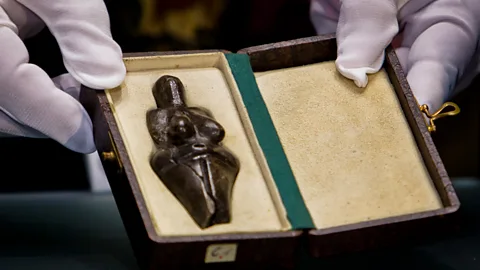 Getty Images
Getty ImagesDespite more than a century and a half of speculation, these nude, faceless sculptures remain utterly enigmatic. Who made them? And what might they have been for?
It's a typical evening at the Hohle Fels cave, around 38,000BC. Outside is a barren expanse of frigid steppe – a frozen landscape with few trees, stalked by cave lions and cave bears. But within, a cosy domestic scene is unfolding: a group of hunter-gatherers is lounging around in a vast natural hall – complete with a cathedral-like ceiling some 30m (98ft) high – illuminated by the flickering glow of an open fire. A woman is absent-mindedly fondling a small ivory figurine hung around her neck – her most valuable possession. Nearby, someone is knapping flint tools. The air is thick with the raspy, haunting sound of a vulture-bone flute, and the smell of roasting mammoth meat.
At least, this is one possible scene that may have unfolded. Some 40,000 years later, archaeologists were excavating at the very same site – a limestone cave in what is now southwestern Germany – when they uncovered six intriguing fragments of ivory, buried under 3m (9.8ft) of sediment. Each was tiny, and when glued back together they made a single figurine – a woman just 6cm (2.4in) high, with a ring at the top instead of a head, possibly so that it could be worn as a pendant. This is the Venus of Hohle Fels, and she is thought to be the oldest representation of a human ever found.
The discovery, which unfolded in 2008, is among the most recent of hundreds of similar finds unearthed as far back as the 19th Century: the Venus figurines. These portable sculptures are usually faceless or even headless, and often have exaggerated sexual features, with protruding breasts, large buttocks, wide hips, clearly defined vulvas, and folds of fat around their bellies. They have been dug up or stumbled upon across Europe and Asia, from the lush foothills of the Pyrenees to the undulating wilderness of central Siberia. But perhaps most remarkably, the overwhelming majority of artworks – which far outnumber any other surviving Stone Age depictions of our species – depict women. "It's quite striking... 99% of them are women," says Katharina Rebay-Salisbury, a professor of the prehistory of humanity at the University of Vienna in Austria.
This is the 160-year enigma of the Venus figurines. Who made them, and why? Are they miniature "mother" goddesses, tangible embodiments of female fecundity? Or could they simply be Palaeolithic pin-ups, the first women to be objectified – both literally and figuratively?
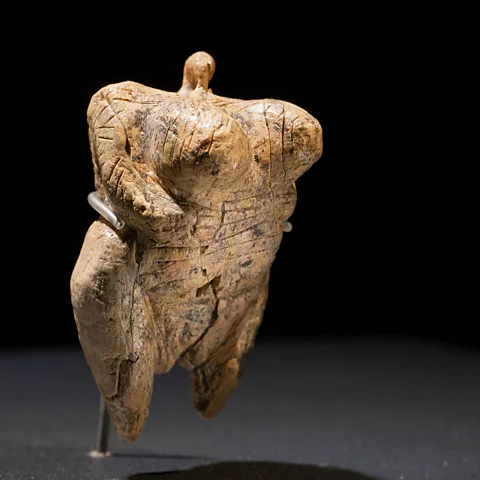 Alamy
AlamyA surprising pattern
One of the earliest Venus figurines to be unearthed was found in the Vézère valley in southern France in 1864 – a region known as the cradle of mankind because of its high density of prehistoric sites. Its discoverer was a curious Marquis, who had been digging around in the immediate aftermath of a professional archaeological excavation. The slim miniature is unusual in that it appears to represent the naked torso of a young girl. It's thought to have been made by the Magdalenian culture, who enjoyed a relatively comfortable, art-rich existence around 11,000-17,000 years ago. The Marquis named it the "Venus impudique", the "immodest Venus", apparently as an acerbic reference to the "modest Venuses" found in classical art – statues of women attempting to cover their nakedness, though often not doing a very thorough job.
International Women's Day
To celebrate International Women's Day, BBC Future takes a look at the prehistoric art that celebrates womankind. Though more recent artworks – including those generated by artificial intelligence – are sometimes biased towards men, in the Stone Age women were centre-stage.
Today more than 200 Venus figurines have been discovered, sculpted from clay or carved out from a wide range of materials including ivory, jet, antler, bone, and various kinds of rock. While some are crude, with just a hint of the female form, many others were manufactured with great care and artistry.
But what has gripped researchers for over a century and a half isn't so much their differences, as their similarities. "I find them fascinating because they're so widespread and there's such a time gap [between when these figurines were manufactured]," says Rebay-Salisbury. "We have figurines that look alike from 17,000 BC and from 38,000 BC. How is it even possible to bridge these unbelievable amounts of time?" she says. That's more than quadruple the separation between the present day and ancient Egypt, for example. The intervals are even more mind-boggling when you consider that Stone Age cultures didn't have access to modern technologies for transmitting information across such long periods, such as writing.
 Getty Images
Getty ImagesTake the Venus of Willendorf, who was discovered at the edge of the Danube river, in northeast Austria, in August 1908. With pendulous breasts, an overhang of fat around her middle, and large buttocks, she has been interpreted as a realistic representation of a severely overweight woman. While she lacks feet and a face, elongated arms with stylised, three-fingered hands rest on her bosom, and her head is covered with what some experts believe is an intricately woven hat. When she was discovered, she was still covered with red ochre, a prehistoric pigment which would have given her skin a terracotta hue, though this was inadvertently dusted off by overzealous cleaning.
The Hohle Fels Venus came around 14,000 years earlier, and yet it has many of the same features. With extremely prominent breasts and a large amount of body fat, like the Venus of Willendorf she has been made without feet or a face. Both also possess a realistic bellybutton, and clearly marked vulva. Rebay-Salisbury explains that these are the classic features of a Venus figurine – reduced heads, feet and arms, and an emphasis on reproductive qualities.
A number of ideas
In the 160 years since the Venus figurines were discovered, there's been no shortage of speculation about what purpose they may have served. For decades, the idea that they were simply pornographic objects, designed primarily for the male gaze, has remained a popular explanation, alongside the view of the artworks as fertility figures.
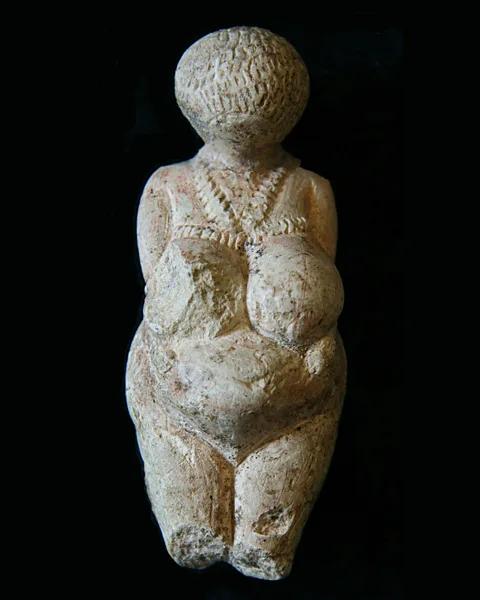 Getty Images
Getty ImagesHowever, there are also more surprising ideas, such as the suggestion that the figurines are headless and footless because they were self-portraits made by women, who sculpted what they saw. In this scenario, the exaggerated breasts, stomachs and vulvas are purely the result of a woman's eye view.
Rebay-Salisbury favours justifications for the Venus figurines that reflect the lifestyles people had at the time. One idea is that they might represent talismans for protecting hearths, she says. It's thought that people didn't tend to form permanent settlements until the Neolithic – when the advent of farming allowed people to produce enough food to stay put year-round. "And so the idea is that you have a figure that you leave behind in a seasonally occupied camp that kind of looks after the hearth," she says.
The theory also provides a neat explanation for how the Venus figurines continued to conform to the same pattern for tens of thousands of years. Instead of the figurines being transmitted from person to person in a continuous culture that lasted for millennia, hearth-protecting figurines that remained at prime locations, such as cosy caves, may have been repeatedly rediscovered by each new group that spent time there, says Rebay-Salisbury.
Another approach is to look for clues to the function of the figurines in the environmental conditions when they were made. Like the majority of the miniature sculptures, the Venus of Willendorf is thought to have been made by the Gravettian people, a sophisticated group of hunter-gatherers who inhabited Europe during the last glacial maximum. During this extreme cold snap, much of Europe was frozen over completely, or encased in creeping glaciers.
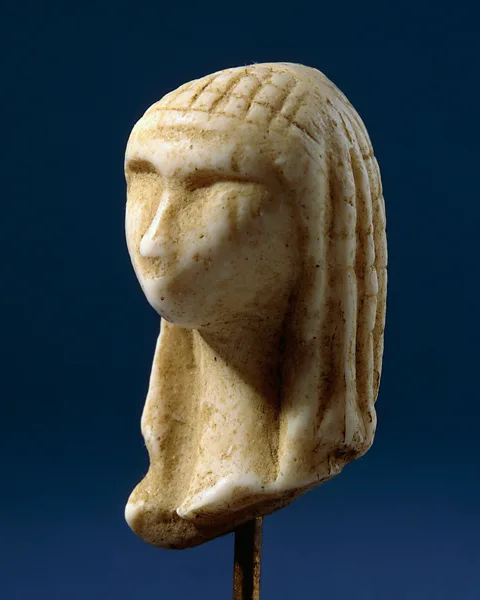 Getty Images
Getty ImagesRichard Johnson, a professor of renal medicine at the University of Colorado Anschutz Medical Campus, is an expert in obesity, and had the idea that perhaps the Venus figurines might have acted as symbols of resilience during this challenging period – when there's evidence of starvation, and populations of Stone Age people began to shrink. In this context, a higher percentage of body fat would have been a major survival advantage – after all, that's what it evolved for.
Together with colleagues, Johnson analysed the waist to hip ratios of Venus figurines found across Eurasia, and found that those created when glaciers were advancing and temperatures were falling tended to depict higher levels of obesity than those made during less climatically challenging periods.
"The reason they depict women is because of this need to have sufficient fat to get through pregnancy," says Johnson. "We've even entertained the idea that there were a few individuals in a tribe – the queen, for example – [who] were picked [out for special treatment], and then purposely given foods that could help them put on fat to provide an assurance to the others that they would have sufficient food," he says. If this was the case, his money is on high-fructose delicacies, in a prehistoric echo of a common pathway to obesity today – though these high-status women would have been provided with natural sources, such as honey.
 Getty Images
Getty ImagesA window to the past
But the Venus figurines aren't just intriguing for what they represent – they can also reveal tantalising details of everyday life tens of thousands of years ago.
Though the Venus of Willendorf was discovered in Austria, an analysis of the rock that she was made from – a kind of limestone called oolite – suggests that it originated in Italy, perhaps prized out of the side of a valley at Sega di Ala, a valley near Lake Garda to the south of the Alps, around 26,000 BC. This puts a large mountain range between where the artwork was mined, and where she ended up. Either a group of hunter-gatherers walked around this geographical obstacle – a journey of around 930km (577 miles) – or they somehow found a way through those peaks, during an ice age. Either of these feats could rewrite the kinds of journeys the Gravettian people were capable of.
 Getty Images
Getty ImagesMeanwhile, other Venus figurines have revealed surprising insights into the technologies available to people during the Stone Age. In the popular imagination, clothing from this era is all furs and animal skins – but the reality may have been more sophisticated. Some women are depicted wearing clothing that appears to be made from plant fibres, including skirts, hats, and bandeaux-style tops, many of which seem to have been created using complex weaving techniques.
But one sculpture carries with it a particularly evocative glimpse into the past: the fingerprint of a child who lived 25,000 years ago. The Venus of Dolni Vestonice was discovered at a prehistoric mammoth-hunting settlement at the foot of Mount Devin, in what is now the Czech Republic. This ceramic figurine was crafted from a mixture of ground-up bone and clay, and appears to have been handled by a young member of the group before it was fired. Perhaps they made it themselves, or maybe they were playing with it as you would a doll. Either way, though their culture has long since vanished, the marks they made remain.
A shifting picture
For now, researchers simply don't have enough information about the Venus figurines, in order to come to any definitive conclusions on their purpose. In the meantime, our interpretations can reveal awkward realities about ourselves. "They are a little bit like mirrors," says Rebay-Salisbury, who has studied how at each cultural moment since their discovery, the artworks have reflected the prevailing concerns and obsessions.
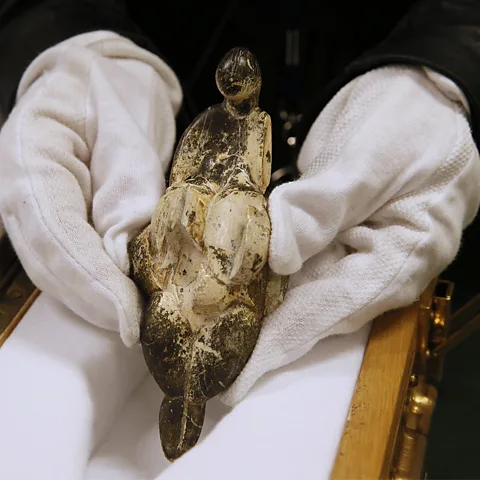 Getty Images
Getty ImagesDuring the colonial era, the Venus of Willendorf was described as a "steatopyge woman" – a racist phrase used to describe the body type of certain ethnic groups. Then with the advent of feminism, these figurines became seen as female goddesses – while today there's the suggestion they're linked to climate change. (Though Johnson believes that this theory is backed up by more scientific evidence than most.)
"I can be very postmodern about it and say that everybody is allowed to read into them what they want, and then they can feel inspired by them," says Rebay-Salisbury. And oddly, this relaxed approach to the Venus figurines may be more true to their prehistoric origins than a quest for a single, clearly defined symbolic meaning. "I think they served multiple purposes in the past, and they continue to do so," she says.
Rebay-Salisbury gives the example of the Venus figurine discovered near the city of Piatra Neamț, in in the Bistrița valley, Romania. Though it was made 17,000 years ago – putting some 9,000 years and 1,000km (621 miles) between it and the Venus of Willendorf – this new figurine is uncannily similar, with one twist. The design has been totally flattened, as though the original had been run over by a truck. "And the only way you can explain this is that people really must have discovered them [other Venus figurines] in the past and produced something similar," she says. However, it might be that the artists behind these two objects had completely different intentions in depicting a woman, she says.
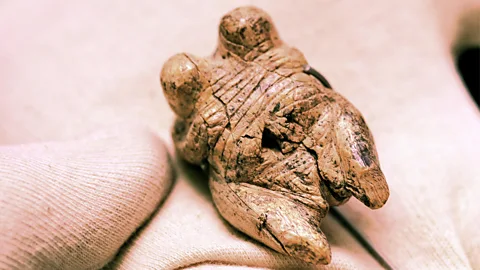 Getty Images
Getty ImagesIn fact, there's some evidence that even within a single culture, there may have been many kinds of Venus figurine, possibly representing different female roles and symbolic meanings. One early analysis identified four distinct types found at just two closely related archaeological sites in southwestern Russia, separated by the subtleties of their posture.
Naturally, Rebay-Salisbury has her own Venus figurine: a golden 3D printed replica of the Venus of Willendorf that lives on her desk. "It's just so nice to have it in my hands… It's clearly made to be handled," she says. Today copies of the sculptures are popular gifts, often sold as "mother goddesses" online. And if the past resilience of the originals is anything to go by, the enthusiasm for these artworks isn't going to disappear anytime soon.
--
If you liked this story, sign up for The Essential List newsletter – a handpicked selection of features, videos and can't-miss news delivered to your inbox every Friday.
